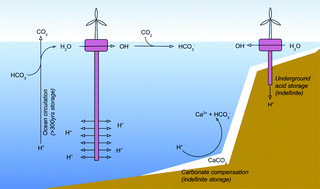CO2 capture by pumping surface acidity to the deep ocean†
Abstract
To remain below 2 °C of warming, most IPCC pathways call for active CO2 removal (CDR). On geological timescales, ocean uptake regulates atmospheric CO2 concentration, with two homeostats driving CO2 uptake: dissolution of deep ocean carbonate deposits (1 ka timescales) and terrestrial weathering of silicate rocks (100 ka timescales). Many current ocean-based CDR proposals effectively act to accelerate the latter. Here we present a method which relies purely on the redistribution and dilution of acidity from a thin layer of the surface ocean to a thicker layer of deep ocean, in order to reduce surface acidification and accelerate carbonate homeostasis. This downward transport could be seen analogous to the action of the natural biological carbon pump. The method offers advantages over other ocean alkalinity and CO2-stripping methods: the conveyance of mass is minimized (acidity is pumped in situ to depth), and expensive mining, grinding and distribution of alkaline material is eliminated. No dilute substance needs to be concentrated, reducing the quantity of seawater to be processed. Finally, no terrestrial material is added to the ocean, avoiding significant alteration of seawater ion concentrations or issues with heavy metal toxicity (encountered in mineral-based alkalinity schemes). The artificial transport of acidity accelerates the natural deep ocean compensation by calcium carbonate. It has been estimated that the total compensation capacity of the ocean is on the order of 1500 GtC. We show through simulation that pumping of ocean acidity could remove up to 150 GtC from the atmosphere by 2100 without excessive increase of local pH. The permanence of the CO2 storage depends on the depth of acid pumping. At >3000 m, ∼85% is retained for at least 300 years, and >50% for at least 2000 years. Shallow pumping (<2000 m) offers more of a stop-gap deferral of emissions for a few hundred years. Uptake efficiency and residence time also vary with the location of acidity pumping. Requiring only local resources (ocean water and energy), this method could be uniquely suited to utilize otherwise-unusable open ocean energy sources at scale. We present a brief techno-economic estimate of 130–250$ per tCO2 at current prices and as low as 93$ per tCO2 under modest learning-curve assumptions.



 Please wait while we load your content...
Please wait while we load your content...